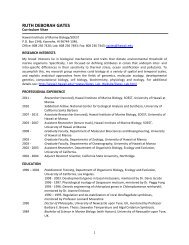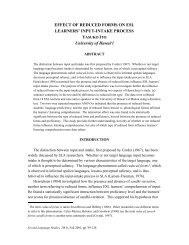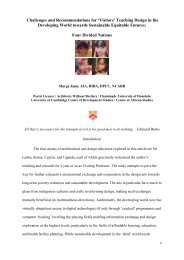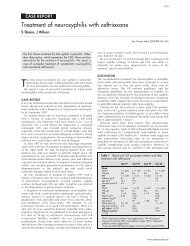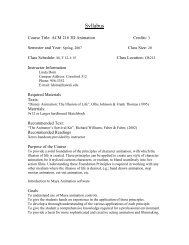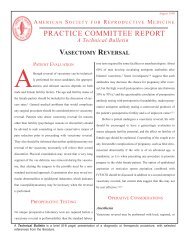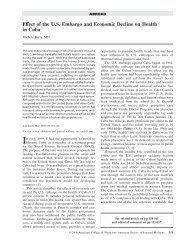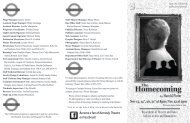Tying and Untying the Trouser-Cord - University of Hawaii
Tying and Untying the Trouser-Cord - University of Hawaii
Tying and Untying the Trouser-Cord - University of Hawaii
Create successful ePaper yourself
Turn your PDF publications into a flip-book with our unique Google optimized e-Paper software.
56 J. W. Frembgen<br />
hadith refer to <strong>the</strong> disapproval <strong>of</strong> tight <strong>and</strong> transparent clo<strong>the</strong>s (Madani 1998, pp.<br />
74 /6). The requirement <strong>of</strong> observing satr is also clearly expressed in <strong>the</strong> following<br />
hadith collected by Tirmizi: ‘Save yourself from nudity because two angels are with<br />
you all <strong>the</strong> time, except when you go to <strong>the</strong> toilet or engage in sexual intercourse; so,<br />
be bashful <strong>of</strong> <strong>the</strong>m <strong>and</strong> respect <strong>the</strong>ir presence.’<br />
In <strong>the</strong> language <strong>of</strong> symbols in Islam, <strong>the</strong> dialectical relationship between virtues<br />
<strong>and</strong> vices is transposed to parts <strong>of</strong> <strong>the</strong> body. Moral character <strong>and</strong> reason (aql) are<br />
thought to be placed in <strong>the</strong> head, whereas <strong>the</strong> nafs al-ammarah, that is, <strong>the</strong> urging or<br />
dem<strong>and</strong>ing soul which is connected with passion <strong>and</strong> desire, is situated in <strong>the</strong> loins.<br />
The lowest value is attributed to <strong>the</strong> feet. Within Sufism <strong>the</strong> moral conflict between<br />
aql <strong>and</strong> nafs is fought as an inner jihad (struggle). As far as <strong>the</strong> differentiation <strong>of</strong><br />
gender in <strong>the</strong> male perspective <strong>of</strong> everyday culture is concerned, men are said to have<br />
aql */intellect, whereas women embody <strong>the</strong> undisciplined impulses <strong>of</strong> <strong>the</strong> nafs */<br />
emotion <strong>and</strong> sexuality. Following this dichotomous folk construction, based on<br />
naturalistic, reductionist views <strong>of</strong> <strong>the</strong> body, women are considered by men to be<br />
sexually wild, dangerously promiscuous, <strong>and</strong> <strong>the</strong>refore easy to seduce. Moreover,<br />
viewed as being closer to nature than to culture, <strong>the</strong>y are thought to be less guided by<br />
reason <strong>and</strong> to have less control over <strong>the</strong>ir ‘unstable’ bodily functions (referring, for<br />
example, to menstruation). Provocative or improper female dressing is <strong>the</strong>refore<br />
interpreted as a positive signal <strong>and</strong> likely to arouse sexual temptation (fitna).<br />
According to <strong>the</strong> hadith collected by al-Bukhari, women represent <strong>the</strong> greatest fitna, a<br />
dangerous, destructive emotion which threatens order <strong>and</strong> stability. Particularly seen<br />
from <strong>the</strong> rigid perspective <strong>of</strong> Islamists, men should domesticate <strong>the</strong> expressive<br />
activities <strong>of</strong> <strong>the</strong>ir women in order to avoid adultery, that is, <strong>the</strong>y should be watchful<br />
that women cover <strong>the</strong>ir sources <strong>of</strong> charm <strong>and</strong> under no circumstances expose<br />
<strong>the</strong>mselves. This strict practice <strong>of</strong> interpreting verses from <strong>the</strong> Qur’an referring to <strong>the</strong><br />
control <strong>of</strong> emotion is also reflected in proverbial expressions suggesting that <strong>the</strong><br />
trouser-cords <strong>of</strong> <strong>the</strong>ir wives is most dear to men. It is even reported that in <strong>the</strong><br />
Mughal period an <strong>of</strong>ficer used to seal <strong>the</strong> trouser-cords <strong>of</strong> his women before he left<br />
for <strong>the</strong> court, but out <strong>of</strong> vexation <strong>the</strong> ladies soon killed him (Annemarie Schimmel,<br />
pers. comm., letter dated 3 April 2000).<br />
The language <strong>of</strong> Islamic dress consequently comprises fixed grammatic rules, which<br />
mean that a morally immaculate <strong>and</strong> virtuous behaviour is achieved through<br />
carefully knotting <strong>the</strong> trouser-cord. Similarly, loosely flowing hair is bound*/bound<br />
hair being a general symbol <strong>of</strong> <strong>the</strong> control <strong>of</strong> female chastity in Muslim societies. In<br />
education, girls <strong>and</strong> boys are advised to pay attention to <strong>the</strong> correctly bound cord.<br />
Maulana Thanawi notes in <strong>the</strong> Tenth Book <strong>of</strong> his Bihishti Zewar: ‘Do not come out <strong>of</strong><br />
<strong>the</strong> privy or bathroom tying your belt, but tie it carefully before coming out’ (Metcalf,<br />
1992, p. 336). 16 Such body management norms are adopted at a subconscious level,<br />
becoming an internalised way <strong>of</strong> correct behaviour in everyday life.<br />
Proverbs <strong>and</strong> sayings recommending modesty in dress <strong>and</strong> comportment reflect<br />
<strong>the</strong> moral responsibility <strong>of</strong> <strong>the</strong> individual for his body seen from <strong>the</strong> emic perspective<br />
<strong>of</strong> Muslim cultures. They are closely related to taqwa, a central Qur’anic concept



